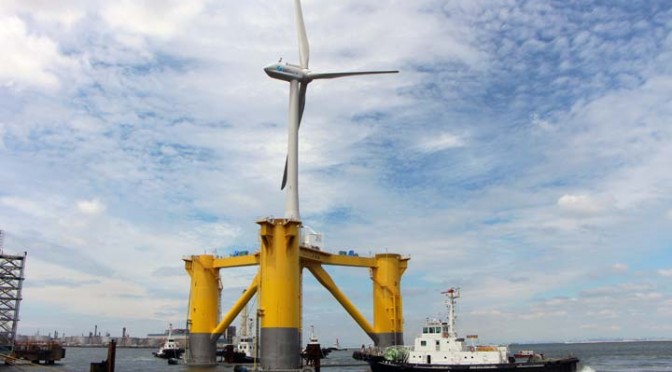A huge amount of electricity supply was lost in Japan when the nuclear power plant at Fukushima was disabled by the devastating earthquake and tsunami in 2011, and compensating for such a loss has required original thinking.
An ingenious solution that is being pursued is to build a network of power-generating systems relying on a freely available source – wind power – in an operational area well within the vicinity, and using floating platforms right off the coast.
This solution, which is being carried out in what is the world’s first experimental project of its sort, requires not only a tremendous amount of effort, but is also a major technological challenge and involves a colossal amount of funding.
Ultimately, the Fukushima Floating Offshore Wind Farm Demonstration Project – also known as Fukushima FORWARD – is aimed at becoming the centre of a new industry that will create employment in this region, helping it to recover from the massive damage brought about by the tragic disaster more than three years ago.
The project is also expected to perform a crucial role in feeding electricity to many key cities, including Tokyo, which had relied on more than 70 per cent of the power generated by the Fukushima nuclear plant before the earthquake and tsunami struck, disabling its operation to this day.
Fukushima FORWARD, which is being carried out by a consortium of Japanese companies with expertise in heavy industry and funded by the country’s Ministry of Economy, Trade and Industry, is now well under way and into its Phase II, in which two of the world’s largest 7-megawatt wind turbines will be installed by year-end, after the first Phase-II works began in June.
During Phase I, one 2MW floating wind turbine and a 25-megavolt-ampere floating power substation were moored off the coast of Fukushima. The former is based on a platform called the Compact Semi-Sub, while the latter is the world’s first floating substation with undersea cables, which were completely put in place last November.
Work on the ambitious project commenced in 2011, just a few months after the disaster occurred in March.
In a recent on-site interview with Professor Takeshi Ishihara of University of Tokyo’s Department of Civil Engineering, School of Engineering, who is the chief technical adviser for the project, journalists from Southeast Asian countries that had been affected by tsunamis were granted exclusive access to detailed information and latest updates on the project.
Ishihara expressed enthusiasm over expectations for the successful operation of the two 7MW wind turbines, despite their being much costlier than the 2MW unit, as the power output would be more than triple while the long-term cost of cable installation, catenary chains and relevant underwater operations would be invested in at one time, at an amount more than three times cheaper than if it took place separately over time.
The 2MW unit – known as Fukushima Mirai – is anchored some 20 kilometres off the coast, in waters 120-metres deep. It has three blades that are each 40m long, a diameter of 80m and stands atop a 32m-high floater.
The substation – Fukushima Kizuna – consists of a transformer to convert the generated electricity to high voltage for transmission to land. It stands 60m above the surface of the sea, and the 66-kilovolt transformer is the first ever to float on the ocean.
The professor said ocean winds were both stronger and more consistent than the onshore type, and Japan’s territorial waters were much larger than its land mass.
While Japan ranks just 62th globally in terms of land area, its territorial waters and exclusive economic zones combined give it the sixth-largest area, he added.
The 2-MW unit’s daily output can feed 1,600 houses, while that of each of the 7MW units can power 6,000 houses, or 12,000 houses in tandem.
Revenue from the sale of electricity will initially cover the operational cost of Fukushima FORWARD, before the project establishes a business model for the floating wind farm and contributes to future commercial projects, Ishihara said.
The works on the 7MW wind turbines and the laying of chains and anchors at the testing area were completed between June and August, as was the shipping, laying and burying of the undersea cable.
Towing of the v-shape, three-column Semi-Sub, which is also called Fukushima Shimpuu, from Nagasaki port to Onahama port will commence on November 1 and be completed on November 10. The schedule for the operation with the other unit – the advanced spar – will be worked out at a later stage.
http://www.nationmultimedia.com


